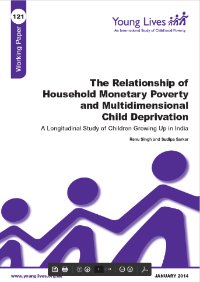The Relationship of Household Monetary Poverty and Multidimensional Child Deprivation: A Longitudinal Study of Children Growing Up in India

WORKING PAPER (121) by Renu Singh and Sudipa Sarkar.
Using the longitudinal dataset from Young Lives, this paper aims to measure multidimensional childhood deprivation in Andhra Pradesh, India. The authors employ the counting approach of Alkire and Foster (2011) and household- and child-related data on 975 children at two different age points (12 and 15 years) and seek to establish the fact that childhood deprivation is not confined only to monetarily poor households.
The analysis is based on 15 indicators cutting across four major dimensions – education, health, housing quality, and subjective well-being - and compares households who have been consistently in the bottom quartile of monthly per capita consumption expenditure (chronically poor) and the top quartile (least poor) in the two rounds of survey conducted in 2006 and 2009.
As might be expected, overall child deprivation is higher for chronically poor households across all the indicators, as compared to those belonging to the least poor households in our sample. However, 95 per cent of children belonging to least poor households face one or more deprivations at both age 12 and 15.
The estimates have also been decomposed by rural and urban location as well as by gender. Rural children in both chronically poor as well as least poor households, experience higher deprivation, which remains static across rounds. Boys at the age of 12 are more deprived than girls in the chronically poor households, although boys show substantial decrease in deprivation over time.
Among the child-related indicators, schooling, ability to read and write, thinness and nutrition have emerged in general as important contributors towards children's deprivation.
The paper recommends social policies to be based on alternative principles of universalism and self-selection to ensure that no child falls between the cracks and to focus efforts to remove child deprivation, particularly in rural areas.
Visit Young Lives to read the paper in full






